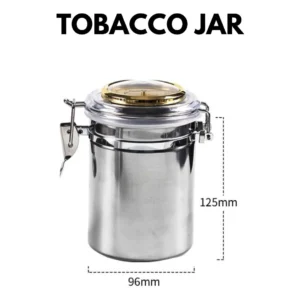When it comes to the world of pipe smoking, few things are as fascinating—or as misunderstood—as the art of pipe tobacco aging. Just as fine wine or cheese improves over time, properly aged pipe tobacco develops depth, smoothness, and complex flavor layers that fresh blends simply cannot match. But what exactly happens during aging, and how can you age your tobacco to perfection? Let’s explore the methods, chemistry, and practical steps that transform good tobacco into a truly exceptional smoke.
1. Why Aging Pipe Tobacco Matters
Every pipe smoker knows that even the finest blend can taste harsh if it’s too fresh. Over time, natural processes inside the leaf alter its chemical composition, softening the nicotine impact, reducing sharpness, and enhancing natural sweetness and aroma.
Companies like McClelland, Dunhill (now Peterson), and Samuel Gawith have historically released limited “aged” editions that cost significantly more—because aging requires both time and care.
However, most enthusiasts prefer to age tobacco at home, creating their own cellar of personalized blends that mature beautifully with patience.
2. The Chemistry of Tobacco Aging
During aging, several slow chemical reactions take place:
-
Oxidation: Nicotine and sugars oxidize, which mellows the tobacco and adds depth.
-
Fermentation: Micro-level fermentation continues in sealed conditions, improving complexity.
-
Maillard reaction: Similar to what happens in cooking, natural sugars and amino acids react to create new aromatic compounds.
The result? A smoother, cooler, and more flavorful smoke. A well-aged Virginia blend, for instance, can lose its sharpness and develop a subtle honey-like sweetness.
3. Proper Conditions for Aging
Successful aging depends on three main factors: temperature, humidity, and air exposure.
-
Temperature: Keep your storage between 15–21°C (59–70°F). Avoid heat sources or sunlight.
-
Humidity: Maintain moderate humidity. Too dry and the leaf becomes brittle; too wet and it risks mold.
-
Air control: Aging requires limited oxygen. This is why most pipe smokers store tobacco in sealed jars or containers.
The ideal environment allows natural reactions to proceed slowly, without the interference of mold or excessive drying.
4. Using a Pipe Tobacco Humidor
Unlike cigar humidors, which are often made of cedar wood, pipe tobacco humidors are typically constructed from stainless steel, glass, or ceramic. These materials prevent aroma contamination and resist corrosion caused by moisture.
Modern humidors often include:
-
A hygrometer to monitor humidity levels.
-
A humidifier (humidifier disc or humidifying gel) to maintain steady moisture.
-
An airtight seal to ensure gradual aging.
For optimal results, lightly mist your tobacco with distilled or boiled-cooled water before sealing. The goal is gentle moisture, not wetness—too much water can trigger mold growth.
5. The Role of the Humidifier and Hydration
Aging pipe tobacco is about balance. You don’t want your tobacco to be too wet or too dry.
For slow aging, the moisture level should stay around 60–65% relative humidity. This keeps the leaf flexible and allows micro-fermentation to occur naturally.
If your tobacco dries out, it can still be revived by using a humidifier or hydration stone, but note that over-hydration can permanently dull the flavor profile.
6. Mixing and Aging Blends
Some pipe smokers experiment by mixing their own blends before aging.
This process allows the different tobaccos—Virginia, Burley, Latakia, or Perique—to marry together over time, resulting in a smoother, more integrated flavor.
The general rule:
“The longer a blend rests, the better it becomes.”
Even a homemade mixture benefits significantly from 6–12 months of proper aging. Complex English or Balkan blends can evolve beautifully over 2–5 years.
7. Time and Patience: The Hidden Ingredient
Time is the most essential element in pipe tobacco aging. While 6 months can soften a blend, true aging happens over several years. Enthusiasts who open a 10-year-old tin often describe it as “a completely different tobacco.”
It’s worth remembering that not all tobaccos age equally:
-
Virginias improve the most with time, gaining sweetness.
-
Burleys darken and mellow but change less dramatically.
-
Latakias can lose some strength over time, so shorter aging is preferred.
Patience is key—aging is as much an emotional process as it is a technical one.
8. The Difference Between Commercial and Home Aging
Commercial “aged tobaccos” sold by major manufacturers often undergo controlled fermentation and temperature cycling, which accelerates some natural processes. However, this is expensive and time-consuming, which is why few companies offer truly aged blends.
In contrast, home aging relies on simplicity and patience—sealed jars, consistent conditions, and careful monitoring. Many connoisseurs argue that home-aged tobaccos taste even better, as they age naturally without industrial shortcuts.

9. Practical Tips for Aging Tobacco at Home
-
Use glass or stainless containers. Avoid plastic—it can affect the aroma.
-
Label jars clearly with the blend name and date.
-
Store in a dark place, away from vibration or temperature fluctuations.
-
Avoid opening jars frequently—each time you open them, you reset the aging process.
-
Rotate your stock. Enjoy some now, keep some for later.
A well-maintained tobacco cellar becomes a living archive of your smoking journey.
10. Final Thoughts: The Living Tobacco
Aged pipe tobacco is not a luxury—it’s a reward for patience and passion. Each jar tells a story of time, chemistry, and craftsmanship. The moment you light a bowl of perfectly aged tobacco, you’re not just smoking a leaf—you’re experiencing years of slow transformation captured in flavor and aroma.
So next time you prepare your blend, seal it in a clean jar, and let time do its work. Your future self will thank you with a smoother, deeper, and infinitely more satisfying smoke.
